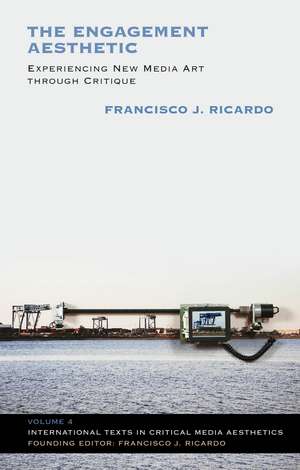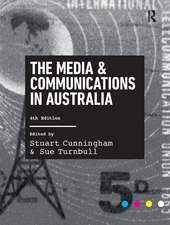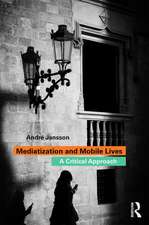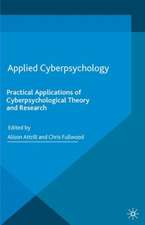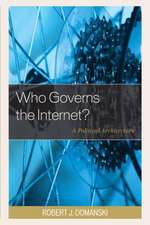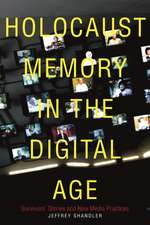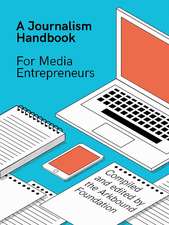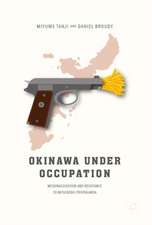The Engagement Aesthetic: Experiencing New Media Art through Critique: International Texts in Critical Media Aesthetics
Autor PhD Francisco J. Ricardoen Limba Engleză Paperback – 17 iul 2013
Preț: 237.28 lei
Preț vechi: 273.05 lei
-13% Nou
Puncte Express: 356
Preț estimativ în valută:
45.40€ • 47.50$ • 37.72£
45.40€ • 47.50$ • 37.72£
Carte tipărită la comandă
Livrare economică 03-17 aprilie
Preluare comenzi: 021 569.72.76
Specificații
ISBN-13: 9781623560409
ISBN-10: 1623560403
Pagini: 256
Ilustrații: 122
Dimensiuni: 140 x 216 x 20 mm
Greutate: 0.34 kg
Editura: Bloomsbury Publishing
Colecția Bloomsbury Academic
Seria International Texts in Critical Media Aesthetics
Locul publicării:New York, United States
ISBN-10: 1623560403
Pagini: 256
Ilustrații: 122
Dimensiuni: 140 x 216 x 20 mm
Greutate: 0.34 kg
Editura: Bloomsbury Publishing
Colecția Bloomsbury Academic
Seria International Texts in Critical Media Aesthetics
Locul publicării:New York, United States
Caracteristici
Creates criteria by which new media art can be distinguished from other contemporary art practices.
Notă biografică
Francisco J. Ricardo, Ph.D., is an art theorist and filmmaker born in Cuba in 1962. His work focuses on new media art and artists. Formerly affiliated with the University Professors of Boston University, he is co-founder of the Digital Video Research Archive, and has taught digital media theory in the Digital+Media Department at the Rhode Island School of Design, USA.
Cuprins
Preface 1. The Engagement Aesthetic - An Introduction PART I. IMAGE 2. Engagement as Meta-Reflection -- Andrew Neumann's Industrial Wall Panels 3. Engagement as Transcendence -- The Transmodal Work of Art 4. Engagement Across the Aural/Visual - Marclay's Media Metonymy 5. Engagement as Post-formal Imagery -- Anne Spalter's Scenes from the North Pole of Transcendence 6. Engagement in Virtual and Actual Gallery Space7. Engagement from Photographic Object to Statement 8. Engagement from Objecthood to Processhood PART II. SPACE 9. Engagement as Nonlocality -- The Aura of the Distributed Moment 10. Engagement in Projective Dance Performance 11. Engagement as Cathexis -- The Affective Index in Video's Depiction of Desire 12. Engagement as Spatial Chronotope in Electronic Art and the Public Sphere 13. Engagement across Space and Structure in Post-Architecture 14. Engagement as Social Spatiality 15. Engagement as Participation, Mediated and Recursive PART III. LANGUAGE 16. Engagement as Post-Literary Mechanism, an Historical Argument 17. Engagement as Post-Literary Mechanism, From Exposition to Reflexivity 18. Engagement as Empirical History -- Metaprogramming 19. Engagement as Comparative Communication -- Formalisms of Digital Text 20. Engagement across Shifting Beliefs: Shamanism, Turing, and ELIZA
Recenzii
The Engagement Aesthetic makes it clear: the importance of new media art resides not in its unique forms and strategies, but in the ways it activates new modes of critique and perception. Theorizing a medium is long work. (Theorists chased after cinema for decades, and continue to do so today.) New media art presents special challenges: its history is short, its forms are diverse, and newer technologies appear regularly, replacing the old. Cleverly, Francisco J. Ricardo overcomes these obstacles by focusing on the relationship between viewer and artwork--an engagement--that is specific to electronic art. With a view to art history and philosophy, the book examines exciting recent artwork (digital installation, performance, audio, text), revealing a phenomenology of the experience of digital art. This exploration will be useful to scholars, students, and artists. The Engagement Aesthetic asks 'Why is new media art different?' Ricardo's great accomplishment is to pose the question in a manner that is insightful, far-reaching, and both timely and timeless.
Ricardo presents a thoroughly considered and novel approach to understanding and appreciating new media art in an expanded field of aesthetic theory. Without throwing away the evaluative function of aesthetics, Ricardo proposes a refocusing of its purpose toward an enacted process of perception, performance, contemplation and critique. He relates this model to the phenomenology of Merleau-Ponty and exercises it through discussions of media production across art, everyday, and entertainment domains. The result is a highly compelling and provocative theoretical framework for linking the old and the new in an emerging field of critical aesthetic discourse.
Ricardo presents a thoroughly considered and novel approach to understanding and appreciating new media art in an expanded field of aesthetic theory. Without throwing away the evaluative function of aesthetics, Ricardo proposes a refocusing of its purpose toward an enacted process of perception, performance, contemplation and critique. He relates this model to the phenomenology of Merleau-Ponty and exercises it through discussions of media production across art, everyday, and entertainment domains. The result is a highly compelling and provocative theoretical framework for linking the old and the new in an emerging field of critical aesthetic discourse.
